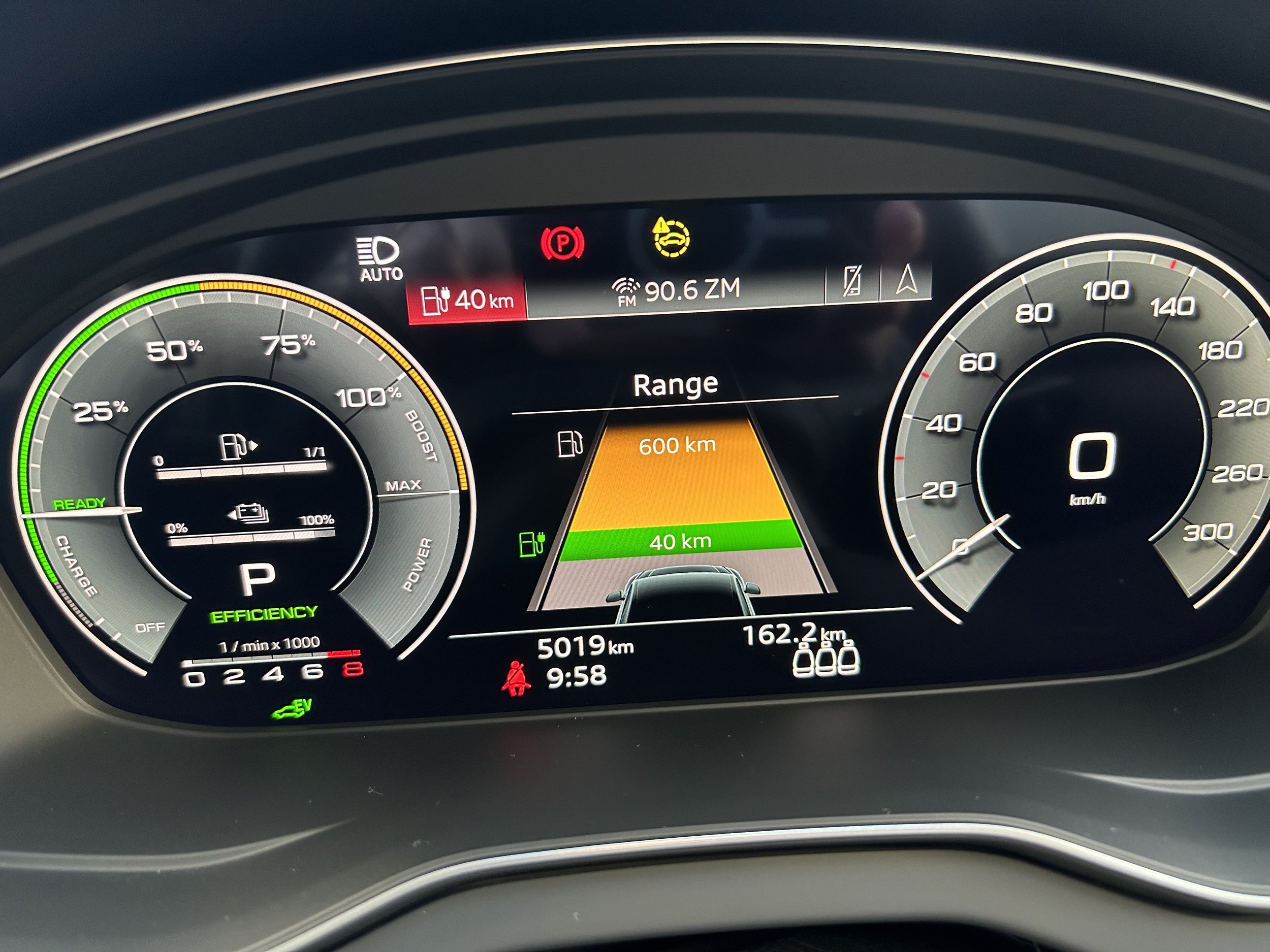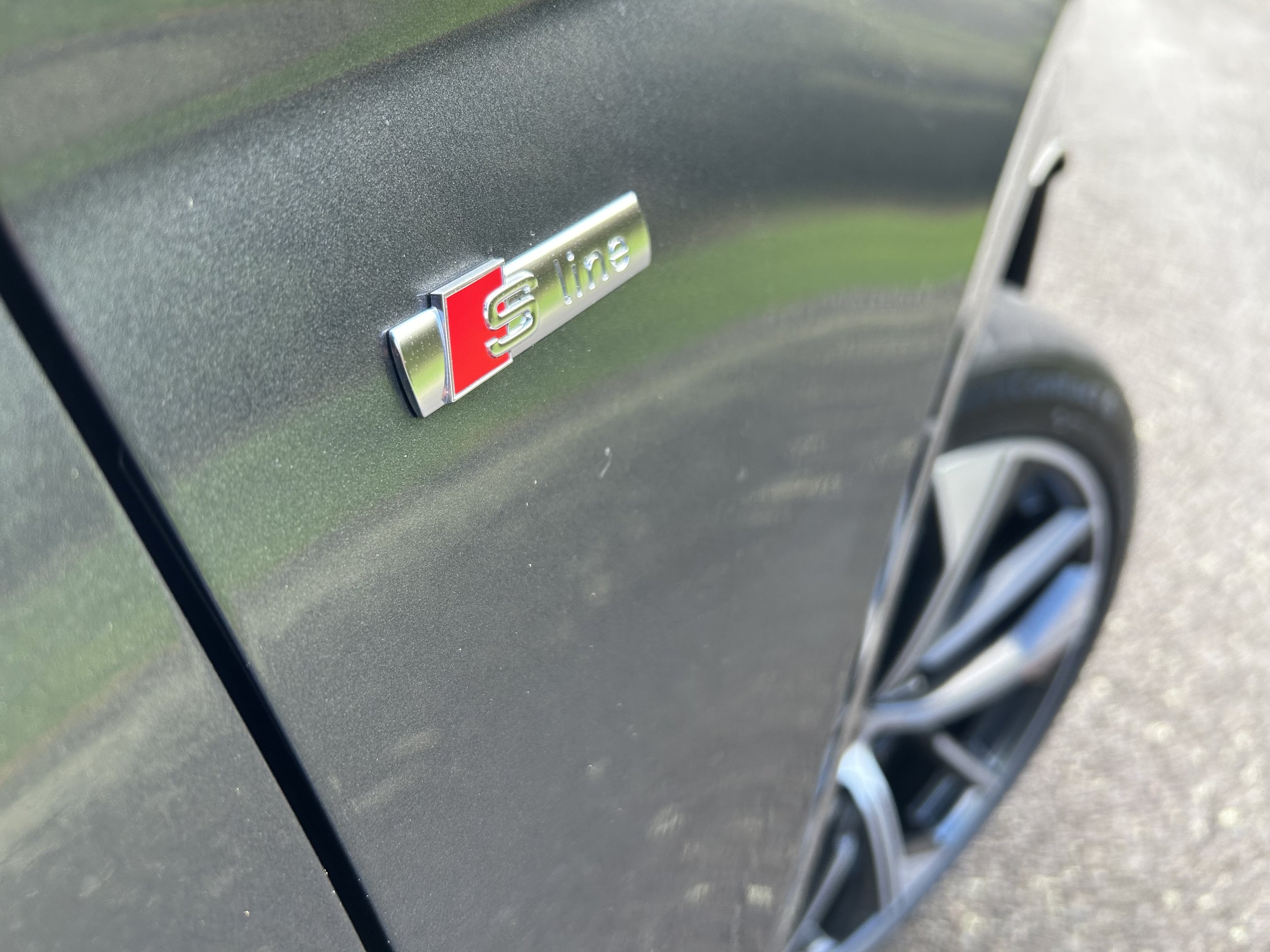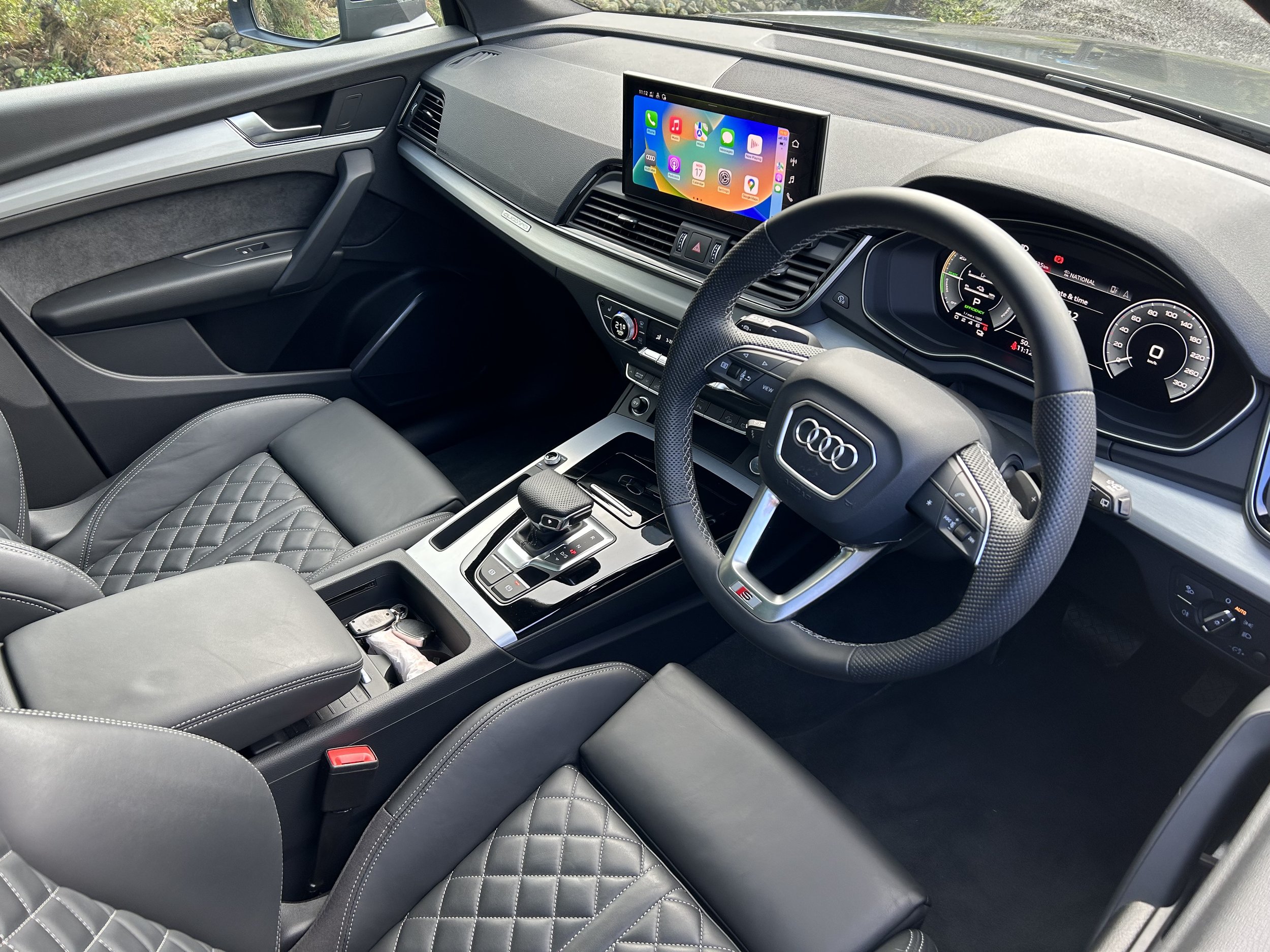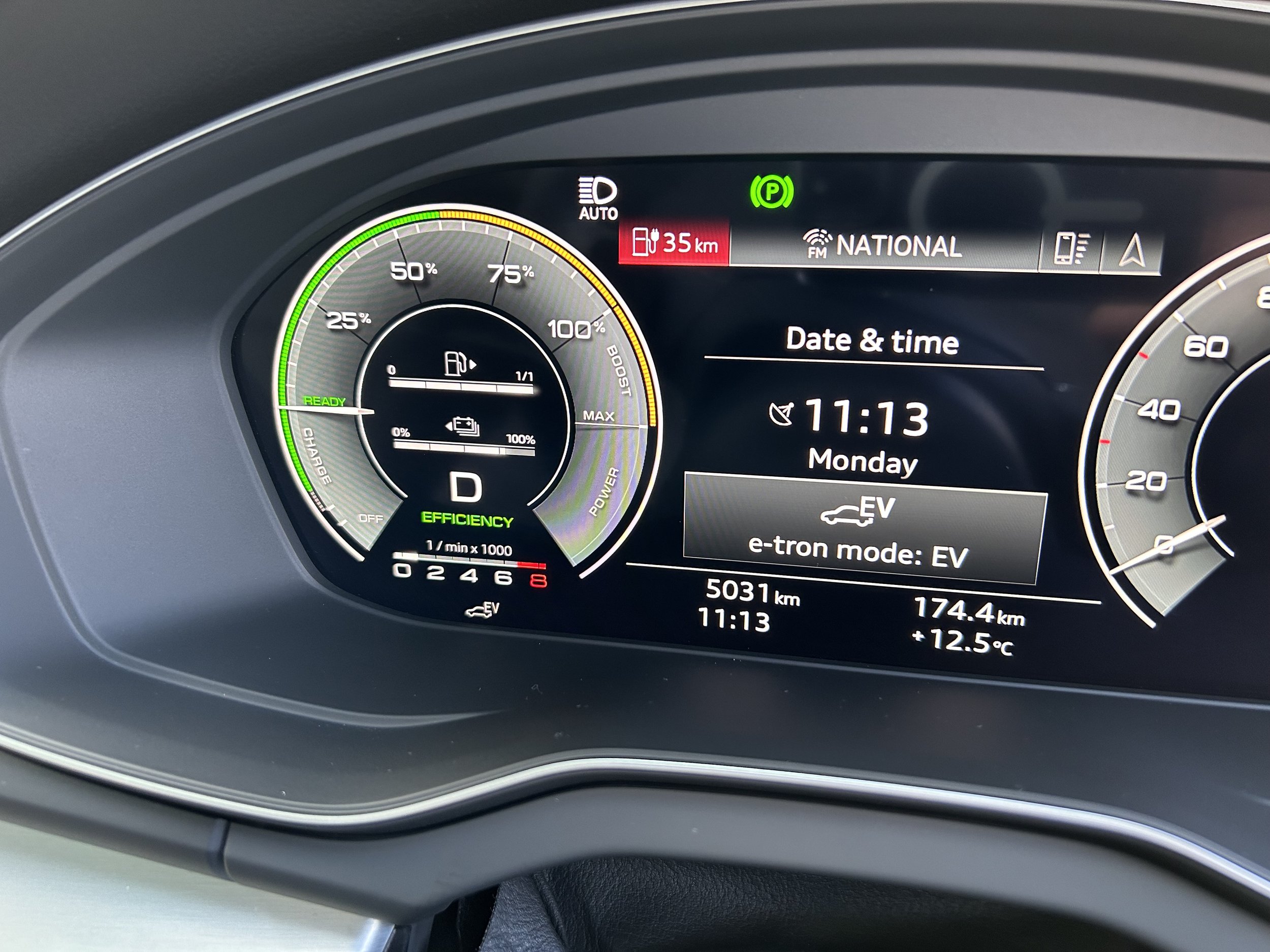Audi Q5 50 TFSI e S Line roadtest review: Moving along quietly
/Diesel is still a Q5 fuel, but there’s now an electric-assisted petrol alternate for those nervous about the dark side.
Price: $114,990 ($125,190 on test).
Powertrain: 2.0-litre four cylinder petrol with 14kWh plug-in lithium-ion battery and electric motor, maximum power 220kW, maximum torque 450Nm (combined), 1.6 litres per 100km cited economy, 48g/km CO2.
Vital statistics: 4689mm long, 2140mm wide, 1659mm high, 2819mm wheelbase, 465 litres luggage capacity, 255/45 R20 tyres.
We like: Premium feel, well-engineered drivetrain, logical operability.
Not so much: Starting to show its age, AC-only charging, transition tech.
HERE it is, an alternate to the modern diesel medium premium sports utility - running a petrol engine with electric assist.
Motoring at the moment is all about moving with the times; the Audi Q5 on test here proves as much.
Appearance-wise, this is a highly familiar car. The second-generation shape has been around for more than a little while; this DNA trace can go back to 2017.
In respect to engineering approach, though, it’s a relatively new concept.
It’s essentially the ‘diesel’ equivalent you have when you don’t want to have anything to do with diesel.
Designed to deliver extra lean economy and, thus, potential for exceptional range, while also cleaning up over all those for emissions.
You all know why Audi has steered this way. VW Group, in brushing itself down in aftermath of a certain incident that somewhat blackened its image, saw benefit from stepping up involvement with electric drive, a programme already on the cards but accelerated as result of the issues of the day.
A plug-in hybrid Q5 using a 2.0-litre petrol engine and an electric motor is one outcome.
The Q4, a fully electric near-lookalike based upon the MEB platform that underpins a three other Group cars also rolling out here - VW ID.4/ID.5, Skoda Enyaq and Cupra Born - is another.
Why have a half-portion when there’s also a fully-laden plate also about to be on offer?
As much as the Q4 is set to end ultimately Audi-philes’ fossil fuel addiction, Ingolstadt sides with general industry view that, for some, while there’s still the option to refuel at a pump rather than with a plug, jumping from a combustion engine into a full EV is a bit of a leap of faith. Plug-in hybrid models provide an opportunity to sample all-electric life, while still having a petrol-fuelled safety net.
On top of that, there’s the cost side of things, though that’s a lot closer run if you don’t watch yourself. Obviously, the Q5 is a premium car, so doesn’t come cheap in any format.
Buying into this Q5 50 TFSI e in standard format means $114,990 spend. A Q4 straight out the box in the dual motor format that is really the closest alternate choice - with safe assumption you want the Audi 101 of all-paw action - and it’s a $126,990 spend. Start ticking options boxes, though, and in the instance of this test car, it came awfully close to Q4 territory. Provisioning in that $4200 panoramic sunroof, 21-inch alloys in Anthrax Black for $4500, and a $1500 Black Gloss styling package raised the sticker to $125,190.
Based on Audi’s long-serving MLB Evo platform, the Q5 is well-established here. The shape you see has DNA link back to a car released in 2017.
It’s getting on a bit, yet is still considered a safe bet by buyers. Even though some aspects of the cabin layout and technology are looking a bit tired, like most other Audi models, it still stands up well for interior quality and perception that the engineering talent runs that little bit deeper in the Audi camp still holds water.
Overall, it remains a car that competes confidently with cars like the BMW X3, Jaguar F-Pace, Porsche Macan and Lexus NX. The Mercedes GLC, having just gone to a whole new generation, could be a problem for it going forward, however.
It’s still a nice car to daily drive. While the suspension can thud a touch over some bumps, the general ride quality is lovely. If effortless transport behind a premium badge is all you need, it makes good impression. Not that it is contained just a box labelled ‘chic urban cruiser’.
Q5s relish carving up a twisty road. The move to on-demand - rather than permanent - four-wheel drive should’t disconcert those wed to old-school Quattro ideals. It’s not a big issue. You’ll struggle to detect the difference in the traction delivered. That’s true both on the tarmac and on looser surfaces. There’s plenty of grip; not too much bodyroll and when understeer does infiltrate, the transition feels carefully engineered-in. In other words, it has safe limits and you know when they’re coming.
So, in short, it’s the Q5 as you’ve always known it. Fuel economy is probably what you’re looking to get a handle on.
That raises another question, given there are still diesels in the family. The SQ5 with a V6 making 251kW and 700Nm might not be considered an alternate, given it’s a $143,990 and upwards ask, but what of the base model that sits at $97,990?
It doesn’t kit out as plushly as the test car, but is still adequate to impress and conundrum of CO2 count of its 2.0-litre aside, is looking handy with 150kW/400Nm and is a slow drinker, too.
But is any diesel as lean as Green as a the 50 TFSI e? Optimally, no.
When best foot is put forward, the PHEV looks spectacular. Outputs a combined 220kW of power and 450Nm of torque assure thanks to involvement from the electric side of the drivetrain, comprising a 105kW motor and 14.4kWh of battery capacity. Audi says this is a car that will get to 100kmh in 6.1 seconds (pipping the 220kW/460Nm Q4 dual motor by 0.1s) and yet also deliver consumption of 1.6 litres per 100km. It’s capable of an electric-only range of 59km, even at highway pace, and
Like-formatted forms conceivably come down to the Lexus NX450h F Spirt, which does slightly better, and a BMW X3 xDrive30e, that delivers slightly worse. But whichever way you go, life looks good, right?
It’s all about keeping everything in context. Anyone who has had any involvement with PHEVs knows manufacturer-cited optimal, though established through a legitimate and worthwhile testing regime, are extremely difficult to match in the real world, only arrive when all elements of the drive system - notably the battery state - are in best-possible state and are, in any case, also fleeting.
That was the experience with this test car. When it was good, it was pretty decent. While initial driving, on a fuel tank and with a fully topped battery, never got the efficiency down to the claimed level, it still looked very good; with a string of sub four litres per 100km readings. The ideal, of course, with a PHEV is to replenish the battery every night, then start each day in strongest state. So long as your trips are reasonably short duration, and speed is reasonably contained, you’ll see brilliant economy. And, yes, it will do that.
That’s the best-case scenario. The worst is to work the engine and also let the battery deplete, to point where it cannot conceivably offer influence. In the car, doesn’t seem possible - even when the battery says it is at zero, there still seems to be some involvement from time to time, Even so, it does make a difference.
A 300km open road trip proved that. It started with the electric side at around 50 percent state and, within an hour of driving, the display was indicating minimal involvement. By end of the drive, the car’s average economy was 6.8 litres per 100km. Given that it supposedly had a flat assistance battery by then, that’s still pretty lean. Potentially better than the base diesel would give. But also, of course, a world away from the absolutes Audi says can occur.
Even so, it is a clever system and one doing its best to give its best, more than you might initially realise. In respect to the car’s MMI system and Virtual Cockpit, the PHEV is fundamentally the same as in any Audi.
Digging into the menus is required to find the hybrid-specific controls, allowing you to cycle between electric-only driving, hybrid, or charge-hold, letting the car drive on its petrol engine to save zero-emission travel for urban areas.
There’s no absolute need for this. Importantly, at start up, the car defaults to EV mode, which is fine around town, but the battery depletes in fairly short order. But if you need to escape the electric, it requires a conscientious effort.
My daily driving route starts out on 100kmh roads, so it seemed best to straight away switch to hybrid mode. The easiest way is to simply pull the Drive selector back, twice because the initial twitch puts it into Sport. It’s influence on long-distance economy seems tangible.
If you aren’t one to involve too seriously, and just want it to get on with what it does without any interference, then it’s not too bad.
While there’s electric juice in good supply, it switches almost imperceptibly from the electric motors to the engine. When the battery is supposedly depleted, this switch becomes more obvious. A colleague who likened the feeling to being not dissimilar to an auto gearbox hesitating between gearshifts nailed it.
It’s a pity there’s no manual involvement with brake regeneration; most PHEVs have steering wheel paddles for this. Not here. instead it relies on the predictive efficiency assistant (PEA) that can adjust the braking effect according to the distance from the vehicle in front and even whether there’s a roundabout coming, according to the sat-nav. Those smarts also involve when you have a route programmed in the car’s mapping software. It then auto-reverts to Hybrid mode and decides how best to use whatever available charge to get to the destination most efficiently.
In addition to being a hushed round-town cruiser, it has serious step when asked. The engine alone feels muscular, but when the electric is in decent health you’re aware of the assistance. You really get a sense of a combustion engine and electric motors working in harmony.
Sure, it’s no outright sports choice. Though the steering is nice and the brakes decent, at 2030kg this Q5 is porky; 50kg heavier than the SQ5 and up to 260kg more than other editions.
The comfort side of things is obvious. Audi doesn’t scrimp on the quality of its materials and everything is finished with flawless precision and attention to detail. The Q5 no longer being Audi’s newest car shows with the its infotainment system. Those who value ease-of-use over technology or drama might like its slightly old-school approach, but it also now looks a little low-brow compared with some other systems.
Q5 measures up well for having a driving position that is suitably commanding and offers plenty of adjustment and a good view. Rear-seat room is okay, too, with decent legroom and headroom.
The PHEV engineering denies this edition some practicality. First to go is the sliding rear bench that in other versions allows you to shift the space available into the boot rather than the passenger compartment. Also, there’s no spare wheel because … well, nowhere to put it.
While Audi cites 465 litres boot capacity, it’s hard to see how that works out. Independent assessment considering practical roominess suggests it lends 155 litres less room than a regular Q5’s boot. I’d simply say that it having to accommodate a really bulky kit bag for the charging addenda is a big faff.
Though the bulkier of the two cables with this car would, if it were in actual ownership, remain in your home garage as it’s a 230-volt home charger, capable of a 32-amp charge, which is well above most ‘trickle’ chargers, the second, lighter one will have to be lugged, as it’s need for some public chargers set up for bring-your-own usage.
If you do lower the second row of seats, the load bay becomes far more impressive but isn’t completely flat as the folded seats lie at an angle. There’s an adequate amount of cubby holes and cupholders dotted around the cabin.
Audi’s PHEV tech doesn’t accommodate DC charging, just the longer slog AC replenishment, and you might wish the recharging port were on the driver’s side (as it would be for left-hook) simply because that make reversing up to rechargers a touch easier. There’s potential for confusion as the petrol and electric filler covers are identical in look and mirrored position on the flanks.
A lot of SUVs get used to tow, if just modest loads, but despite a towing assembly being available for the PHEV, it’s not clear if this is for hauling or simply as a mounting post for a bike rack. The regular Q5 is rated to tow just over two tonnes and the Q4 will haul 1200kg.
About the latter. This time next year, the fully electric almost-sibling might be so well established the PHEV could well be an afterthought. Or, alternately, the Q5 itself might be checking out the retirement home scene.
At the moment, the electric choice is pricier and somewhat more limited for range; 511 kays before exhaustion according to the same measuring tool used to evaluate this Q5’s potential of close to 700km. On the other hand, we all know what the future is that this Q5 is but a stepping stone to it.























